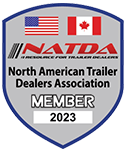Trailer tires can be susceptible to frustrating and inconvenient problems. Knowing how to diagnose and address common issues can help you stay safe on the road and avoid unexpected breakdowns.
Here are some of the most common problems with trailer tires and how you can fix them:
• Tire Blowout. A blowout occurs when the tire suddenly bursts, often due to overloading, low tire pressure, or sharp objects on the road. If a tire blows out while driving, keep the steering wheel steady. Slow down and safely pull over to the side of the road. Replace the damaged tire with a spare, following the manufacturer’s instructions, and inspect the other tires for problems.
• Low Tire Pressure. Low tire pressure can lead to poor handling, reduced fuel efficiency, and a higher risk of blowouts. Regularly check and maintain the proper tire pressure according to the manufacturer’s recommendations, using a tire pressure gauge to ensure accuracy. Inflate the tire to the recommended PSI, which is typically labeled on the tire’s sidewall.
• Uneven Tire Wear. Uneven tire wear results from misalignment, improper inflation, or unbalanced tires. Inspect the tires for signs of uneven wear, such as one side wearing out faster than the other. Make sure to address the underlying issue, which may involve realigning the axles, rebalancing the tires, or adjusting tire pressure. Regularly rotate your trailer tires to promote even wear.
• Punctures and Cuts. Punctures and cuts in the tire tread lead to slow leaks or sudden blowouts. Small punctures can often be fixed using a tire plug kit, but larger or more severe damage may require you to replace the tire.
• Dry Rot or Cracks. Trailer tires can gradually develop dry rot or cracks in the sidewalls due to sun exposure and old age. Regularly inspect your trailer tires for signs of dry rot or cracks, especially if store your trailer outside. If you notice extensive cracking or dry rot, it’s best to replace the affected tires to stay safe on the road.




